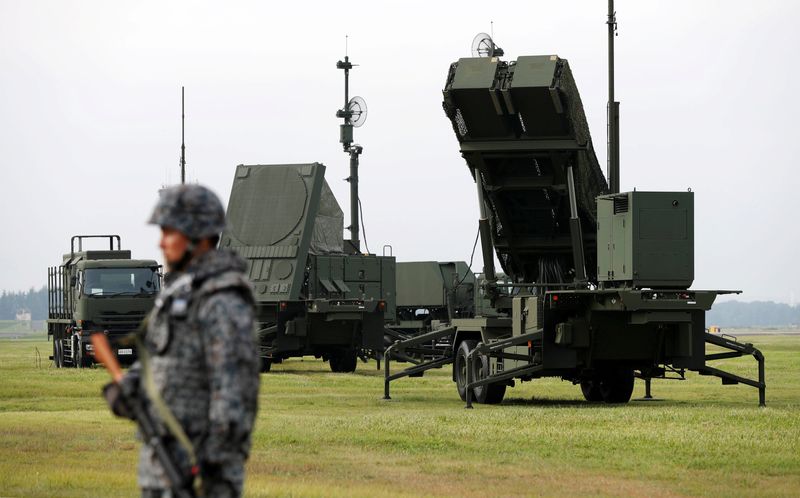By Mike Stone and Gerry Doyle
WASHINGTON/SINGAPORE (Reuters) - Fearing China will deploy hypersonic weapons to sink ships in the Pacific, the U.S. Navy is moving forward with a plan to arm some of its vessels with Patriot interceptor missiles, two senior defense officials said.
One industry official said putting the highly agile Patriot Advanced Capability-3 Missile Segment Enhancement (PAC-3 MSE) interceptors, used primarily in the U.S. by the Army, aboard Navy ships anticipates advances in Chinese missile technology, including the use of highly maneuverable hypersonic weapons.
Integrating the Lockheed Martin-made missiles with ships' air defenses comes amid simmering tension in the Indo-Pacific region as China rapidly modernizes its military, and in the wake of successful missile defense efforts in Ukraine and the Middle East.
How many PAC-3 interceptors the Navy will need is uncertain, but overall demand is "through the roof," said Tom Karako, a missile defense expert at the Center for Strategic and International Studies in Washington.
He said there was strong interest from foreign governments adding that the U.S. Army wants to more than double production in coming years.
The U.S. has tapped Japan, a key ally, as a location for joint production of Patriot missiles, and Lockheed Martin (NYSE:LMT) wants to establish a new production line for the missiles' seekers in Florida, industry sources have told Reuters.
That plant would complement Boeing (NYSE:BA)'s seeker manufacturing efforts, and Lockheed Martin is pitching the benefits of additional production to the U.S. Army, which must sign off on it.
The PAC-3 has already shot down maneuvering hypersonic missiles in Ukraine. The Navy thinks it could add another high-probability layer to its anti-missile systems, which have not been battle-tested against such weapons.
The Navy told Reuters, "More testing is required in the development roadmap that will include launching PAC-3 MSE from a ship and validating communication with the SPY-1 radar," the main sensor in the Aegis missile system.
That follows efforts by the U.S. military that have already yielded new weapons and new strategies in the Indo-Pacific aimed at deterring Beijing from a conflict, or winning one if it occurs.
Beijing's most sophisticated anti-ship ballistic missile, the DF-27, which uses a hypersonic glide vehicle to maneuver to its target, was tested in 2023. The Pentagon's China military report that year said the weapon was "in development".
The PAC-3 is shorter-ranged than the Navy's SM-6 missiles and cannot reach into space.
But steering rockets near the nose make it more agile, and destruction of the threat is more likely because of its "hit to kill" concept, in which the interceptor strikes the target rather than explode near it, said a missile defense program director with direct knowledge of the Aegis system.
Facing advanced Chinese weapons, including hypersonic glide vehicle warheads, those qualities "supplement the existing missiles on a U.S. ship very well" by being able to more easily hit high-speed, maneuvering ballistic missiles and destroy them, said the program director.
Like the industry and defense officials, he declined to be identified as he was not authorized to speak to the media.
GROWING THREAT
A PAC-3 interceptor from a Patriot missile system, primarily used by the U.S. Army and allied nations for land-based air defense, was tested in May on a "virtual Aegis ship" using a Mk. 70 vertical launcher, but has not been deployed on naval vessels.
In the last year, however, it has intercepted numerous ballistic threats and aircraft in the Middle East and Ukraine, including Russia's advanced Khinzal missiles, making it an attractive addition to Navy magazines, the defense officials and people familiar with the matter said.
The PAC-3 round is also much smaller than an SM-6 or SM-3, weighing about 300 kg (660 lbs), compared with 1,500 kg for the SM-6, and is about 9 cm (3.5 inches) smaller in diameter.
Cost per missile varies by the customer and the deal, but both are roughly $4 million each, according to estimates.

China has already developed a formidable arsenal of anti-ship ballistic missiles, including the DF-21D "carrier killer," and anti-ship warheads for its DF-26 intermediate-range ballistic missile (IRBM).
Its DF-27, which the Pentagon says could reach as far as 8,000 km (5,000 miles), appears to use an aerodynamic warhead that can maneuver to evade defences or more easily hit a moving target, said Tim Wright of the missile defense initiative team at the International Institute of Strategic Studies.
